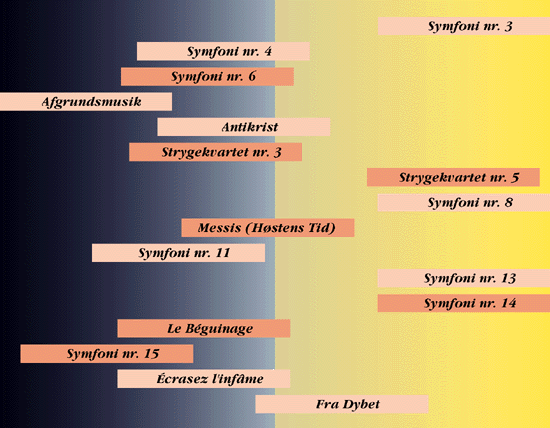Beauty and decline
An attempt to answer the question:
"What is Langgaard's music
basically 'about'?"
If one is to reach a comprehensive interpretation of Langgaard's
oeuvre, one has to begin by regarding the whole of his widely diversified
production under one heading, as a unity. This can be done if one
accepts that the common denominators of Langgaard's music are to be found at
the level of ideas rather than at the level of the music itself.
There are two dominating themes that run through and permeate the whole of Langgaard's production, each at its own level in terms of ideas. The first is that Langgaard's music is basically about music itself, it is Music on music. The second theme may be called BEAUTY AND DECLINE.
All of Langgaard's music may be said to move along the continuum of a
dualistic tension between a 'destructive' and a 'constructive' pole, between
'Beauty' and 'Decline', Light and Dark, Christ and Antichrist. In fact,
Langgaard's works can be placed on a sliding scale, from those most taken up
with decline to those most concerned with the search for beauty.
Click
on some of the titles of the illustrations below to see what all this is about
in musical terms.
Beauty and decline. Light and dark.
The
constructive and destructive principles in Langgaard's music.
Some of the works reveal an exclusive interest in beauty - the elevated, paradisical (utopian) harmony which according to Langgaard only romantic music can express - whilst others deal with 'decline' in a variety of ways: the end of the world, the decline of art, the drowning of romantic ideals in the seething cauldron of the 20th century, and even the decline and demise of the composer himself.
In several of the works, this polarity is expressed by the 'collision' between two different modes of expression juxtaposed without any intermediary. Examples of this are the central movement Høstens Tid (The Harvest Time) from the organ work, Messis. Other similar works are the prelude to the opera, Antikrist (Antichrist) and the choral work Fra Dybet (From the Deep). This way of presenting things may appear naive, but is in complete conformity with the composer's religious view of life and music.
Hardly so naive, but very characteristic, is the fact that several of the important works situate themselves in a sort of middle area, where beauty and decline, in a diabolical, mystical fashion, present two sides of the same case, and where the element of decline is built into the romantic mood itself. This is particularly true of the opera, Antikrist (Fortabelsen) (Antichrist - Damnation), and of the organ work, Messis (Høstens Tid) (Messis - The Harvest Time), even though these works are based on separate principles, namely 'the destructive' (Antichrist) and 'the constructive' (Christ).
Bendt Viinholt Nielsen, 1996.
![]()
![]()
![]()
![]()

